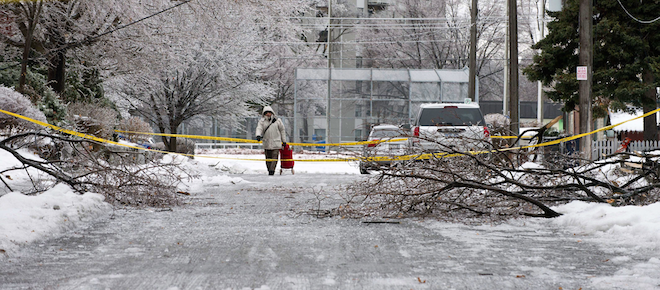Why a ‘state of emergency’ preoccupied #darkTO
Emma Teitel on the comical debate about semantics
Share

On Sunday, Dec. 22, a massive ice storm hit my city, shattering trees, decimating power lines and robbing roughly 300,000 Torontonians of power. A friend of mine left a party in the city’s west end half-drunk on Sunday morning and found himself dodging falling branches and wires on his walk home, “like Indiana Jones.” For almost a week, large pockets of the city were dark and frigid. Christmas, possibly for the first time in its heavily storied history, was desperate for a Chanukah miracle, for a light that would keep on burning magically without fuel. No miracle was in the offing. Despite Toronto Hydro’s best efforts, thousands would spend Dec. 25 in the dark.
Toronto’s ice storm, dubbed “#darkTO” on Twitter (because everything of note must now have a hashtag), was rife with stories of neighbourly spirit and civic duty. People took strangers into their homes, and hydro workers became superheroes. But beyond the city’s Good Samaritan vibe, T.O. residents were anxious to know when their power would return—and, most of all, it seemed, they were anxious to know if or when Rob Ford, our figurehead for a mayor, would declare a “state of emergency” in the city. “State of emergency” was all we heard about for a week. Was our ice storm worthy of this special distinction, defined by heightened government attention, intervention and some intangible stamp of bonafide graveness? We knew we were in an emergency—but were we in an official state of?
The debate would become almost comical, the semantics impossible to decipher. Some of Toronto’s left-leaning councillors, my own included, argued that we might as well use all the extra resources an S.O.E. would grant us. “I can’t imagine why we wouldn’t use every tool in the tool box,” said city Coun. Josh Colle. Some ridiculed the councillors for demanding it, because, according to Rob Ford and Ontario Premier Kathleen Wynne, who continue to avoid one another like the plague, we were using every tool in the toolbox.
They assured us that the city would receive provincial assistance, whether an S.O.E. was called or not, and it did: Hydro workers even came in from the U.S. on Christmas Day. It soon became very clear that the difference between a regular run-of-the-mill emergency and an official “state of emergency” was, in this case, about as material as Santa Claus. So why did we care so much that someone make the declaration in the first place?
We cared, perhaps, because emergencies are very personal things. If you were ex-Toronto mayor Mel Lastman, for instance, the ice storm probably looked like the End of Days. (Lastman is notorious for having summoned the army in 1999 to deal with a snowstorm in downtown T.O.) If, on the other hand, you were a character in the recent zombie apocalypse film State of Emergency, #darkTO might look like the environmental equivalent of stubbing your toe. And if you were Kathleen Holding, you would consider it something very simple, a dire circumstance in the present tense: Holding, a Scarborough resident with multiple sclerosis, spent the storm, she told the Toronto Star, in a dark and freezing basement, probably feeling as alone as it’s possible to feel.
A state of emergency is for the Kathleen Holdings of the world. The official announcement doesn’t change the stakes or the seriousness of the disaster, in this case, but it does relieve the sense that you’ve been forgotten. The most bizarre and surreal elements in Toronto’s ice storm this past week weren’t the strewn tree limbs and collapsing wires, but the relative quiet and serenity in neighbourhoods— like mine—that remained largely unaffected, and the influx of Instagram photos chronicling the storm’s icy beauty. The small swath of the city I live in was so undisturbed, I might have been a citizen of another country.
Which, in a way, made me the adversary. No one should be at ease in an emergency. But the disconnectedness of a big city can blind us to pain that lingers across town, or next door. A state of emergency, then, is the bureaucratic antidote to the human instinct English poet W.H. Auden describes in his famous poem, Musée des Beaux Arts, which refers to a painting by Pieter Brueghel the Elder called Landscape With the Fall of Icarus. Icarus was the mythical son of the genius Greek inventor Daedalus, who died while escaping captivity with his father, using a pair of wings Daedalus had fashioned out of feathers and wax. Icarus flew too close to the sun, the wax melted and he plunged to his death in the sea.
The strange thing about Brueghel’s painting is that, for a person seeing it for the first time, Icarus doesn’t appear to be in it: It’s just a peaceful landscape, farmland over an ocean bay on a sunlit day, a beautiful ship sailing across the water. It’s only when you look closely at the lower-right corner of the picture that you notice a pair of bare legs disappearing, upside down, into the sea, with feathers floating down around them. Auden’s poem starts by noting that the Old Masters were never wrong about suffering:
… how well they understood / Its human position: how it takes place / While someone else is eating or opening a window or just walking dully along …
And it ends:
In Brueghel’s Icarus, for instance: how everything turns away / Quite leisurely from the disaster; the ploughman may / Have heard the splash, the forsaken cry, / But for him it was not an important failure . . . and the expensive delicate ship that must have seen / Something amazing, a boy falling out of the sky, / Had somewhere to get to and sailed calmly on.
A state of emergency says: “This disaster is important. Do not sail calmly on.”